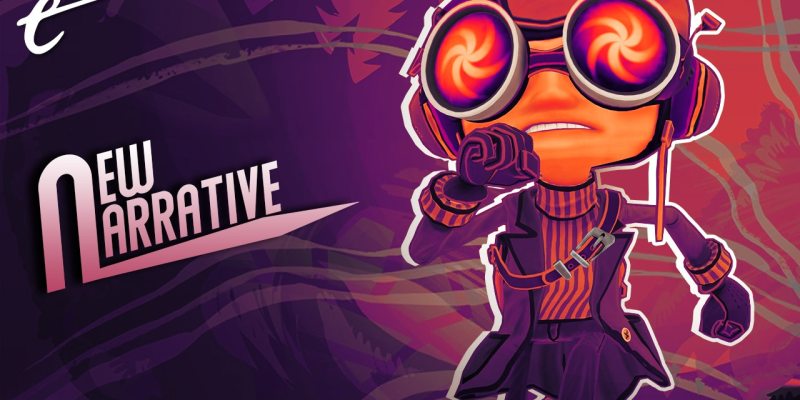This article contains some light spoilers for Psychonauts 2 and PSI-King’s Sensorium.
The last couple of console generations have brought us instant classics of level design: Titanfall 2’s Effect and Cause, Dishonored 2’s The Clockwork Mansion and A Crack in the Slab, Rez Infinite’s Area X, and others. There is sometimes a bit of snobbery in the selection. Dishonored 2, for example, is part of the venerated immersive sim design philosophy, while Rez Infinite pursues its lead designer Tetsuya Mizuguchi’s long-held ambition to achieve synesthesia through gaming. In other words, these are the examples one is supposed to pick – they are the Citizen Kane of “refined” game opinion, if you will.
At first glance, Psychonauts 2 doesn’t fit the bill. It’s a cartoon-styled platformer about a psychic 10-year-old boy, Raz Aquato, trying to find a new home in the psychic equivalent of high school while unraveling a global conspiracy, supported by an endearing cast of characters, dad jokes, and jazz. It’s like a Pixar film in motion, and you are not supposed to talk about Toy Story in the same breath as Citizen Kane, right?
But Psychonauts 2 has some of the best level design I’ve encountered in years, which deserves to be remembered next to Effect and Cause or The Clockwork Mansion. There are plenty of excellent candidates to choose from. Bob’s Bottles features a burp mechanic that temporarily clears an area of water to allow Raz to platform across. Cassie’s Collection has 2D hopping and climbing across letters on the pages of a book and hilarious pastiches of beloved literary characters. Compton’s Cookoff requires Raz to cook sentient ingredients in a timed challenge and then fight overfed food critics as they vomit his dishes back at him in a gladiatorial arena.
Yet for my money the best level of Psychonauts 2 is PSI-King’s Sensorium. On the face of it, it might lack the mad imagination and creativity of some of the other locations in the game, but it’s a nearly perfect combination of gameplay, art, story, voice acting, and score. There is even a bit of philosophy mixed in, for anyone who really must insist that games have to grapple with serious ideas.

The key concept in Psychonauts 2, as in Psychonauts, is that Raz can enter the mind of other characters, to heal them or to learn vital information. Roughly halfway through the campaign he needs to find a replacement brain for a colleague. Luckily, a senior psychonaut keeps a collection of brains in jars.
In Psychonauts lore, after a long time of sensory deprivation, a mind falls into a kind of content-deprived state – entering the mind reveals a dark void populated by the barest outlines of memories, thoughts, and concepts. While the brain in a jar is an obvious allusion to the infamous brain-in-a-vat thought experiment in philosophy, the idea that sensory input is necessary for the development of thought could be a reference to so-called externalism about the mind.
In order to restore this mind to its normal function, Raz needs to find and unite its five sense modalities: touch, smell, taste, sight, and hearing. It seems the idea is that this mind may be heavily dependent on synesthesia – triggering an experience in one modality leads to experiences in others, ultimately restoring the mind’s unity of consciousness.
The sense modalities are represented literally: Touch is a giant hand, sight an enormous eye, and so on. The story goes that they used to be in a rock band – one that could have stepped off the cover of Sergeant Pepper’s Lonely Hearts Club Band while doing LSD with Jefferson Airplane. Reuniting the sense modalities means bringing the old band back together again.

The metaphor is taken to its logical extreme in PSI-King’s Sensorium. Raz travels around the grounds of a festival in a 1960s Volkswagen camper van in his search for the stray band members. Each location is crammed with hallucinatory scenery. Raz refracts light to create Dark Side of the Moon-esque bridges across bottomless chasms, dodges lapping Rolling Stones tongues, and dashes between eyeballs that wouldn’t be out of place in 13th Floor Elevators’ liner notes. The whole thing is tied together by a color filter of acid-trip green, an art style somewhere between cel shading and pop art, and a psychedelic rock soundtrack that somehow manages to complement the wistfulness and warmth of the game while paying homage to the free-spirited side of the ‘60s.
Occasionally, Raz needs to pause to fight censoring thoughts, regrets, doubts, and panic attacks that spring to life as the mind is temporarily overwhelmed by the newly rediscovered sensations. It’s a welcome change of pace from the platforming, but it’s also delivered in short bursts, recognizing that combat is Psychonauts 2’s weakest element.
Meanwhile, quips from the mind Raz is trying to restore contribute to the narrative, voiced with Jack Black’s barely contained manic energy. There is a pang of nostalgia to this – Jack Black voiced the protagonist in Double Fine’s heavy metal homage Brütal Legend, which I played a lot of during a more carefree time, not to mention the unhealthy amount of Tenacious D I listened to as a teenager. It also makes for some expert comedy timing, a final reveal that delivers one of Psychonauts 2’s main plot developments, and a musical number that is easily better than anything found on the D’s last couple of albums.
In short, PSI-King’s Sensorium is the complete package, doled out in short bursts of platforming, combat, story, and comedy. And while it might look like a light-hearted rock gig metaphor, there is a lot more going on backstage. At a time when so many games deliver dark, grim, and grimy worlds that take themselves very seriously, it’s refreshing precisely because Psychonauts 2 isn’t any of those things – it has interesting things to say and do without ever losing its sense of fun.
